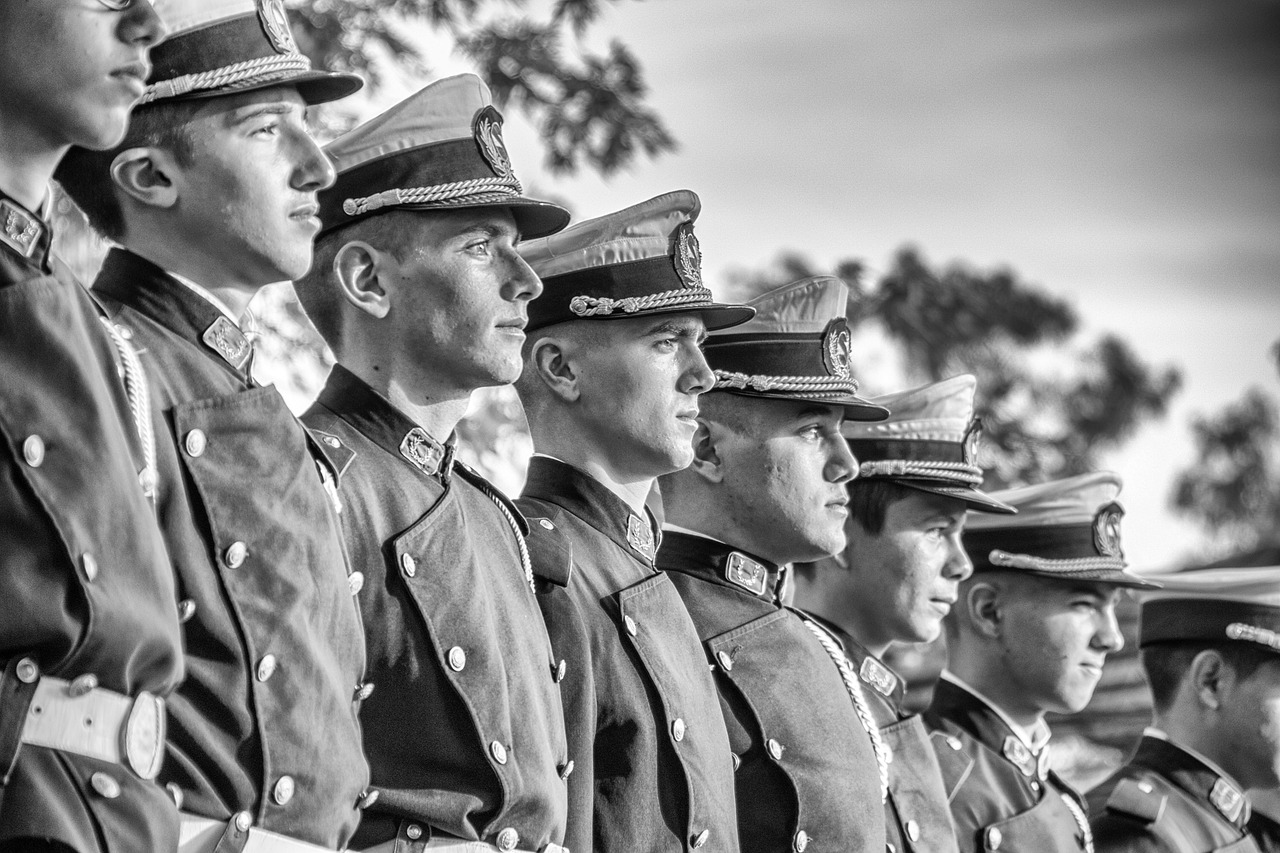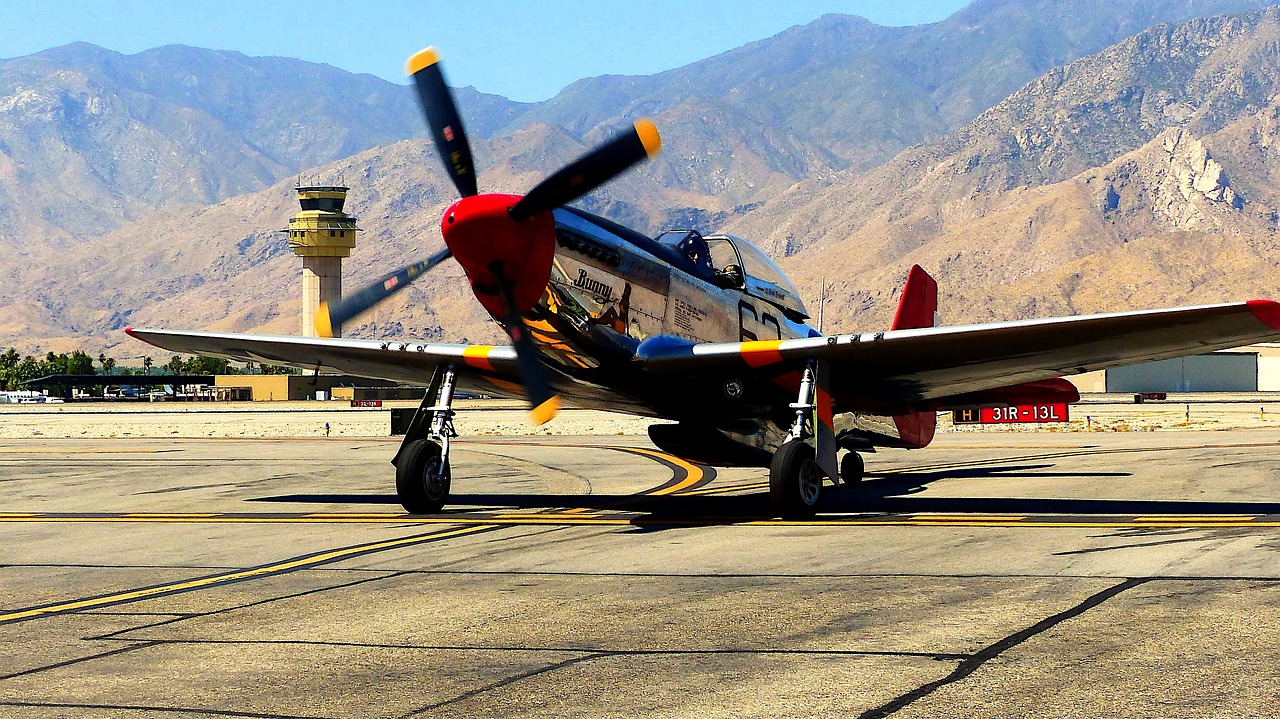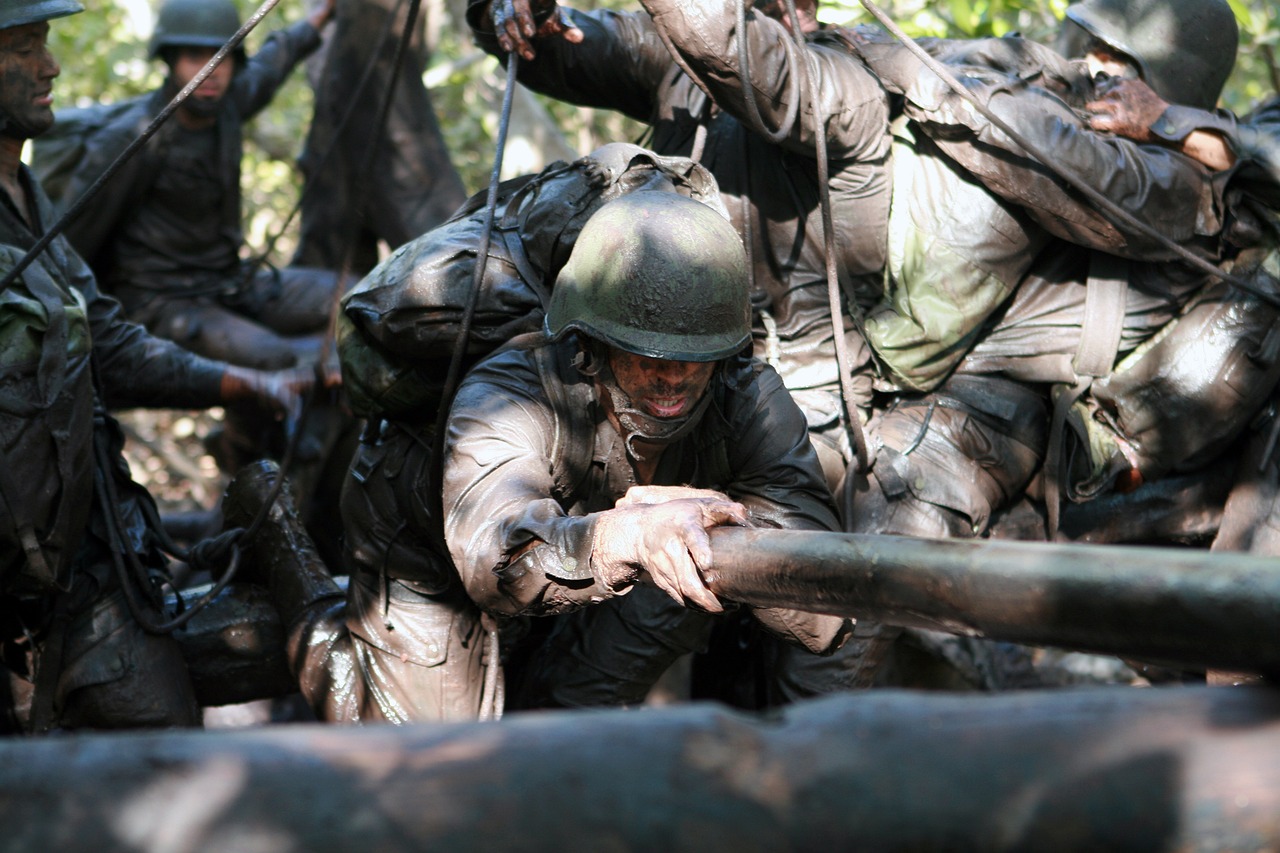Analyzing the Cost-Effectiveness of VR in Military Training Programs
In today's rapidly evolving technological landscape, the military is constantly seeking innovative ways to enhance training efficiency and effectiveness. One of the most promising advancements is Virtual Reality (VR). This article explores the financial implications and benefits of implementing VR technology in military training, assessing its effectiveness compared to traditional methods and its potential for future applications. As we delve deeper, we will uncover how VR not only transforms training methodologies but also offers a more cost-effective solution in the long run.
Virtual Reality is more than just a buzzword; it's a revolutionary tool that immerses users in a 3D environment, allowing them to experience scenarios that mimic real-life situations. In the military context, VR encompasses a range of technologies, including headsets, motion tracking devices, and interactive simulations. These components work together to create a lifelike training experience that enhances learning and operational readiness. Imagine a soldier practicing combat maneuvers in a virtual battlefield, where every movement feels real without the associated risks. This level of immersion not only prepares personnel for high-pressure situations but also allows for repeated practice without the wear and tear on physical resources.
To fully appreciate the cost-effectiveness of VR, we first need to understand the expenses tied to conventional military training methods. Traditional training often involves significant personnel costs, equipment maintenance, and various logistical challenges. For instance, the costs associated with transporting troops, maintaining equipment, and securing training venues can quickly add up, establishing a hefty baseline for comparison. In fact, many military organizations find themselves grappling with budget overruns that could be mitigated through the adoption of more efficient training technologies.
When it comes to traditional training methods, the allocation of personnel and resources is a critical factor. Training exercises often require large teams of instructors, support staff, and trainees, all of whom need to be coordinated effectively. This not only strains the budget but also impacts overall efficiency. For example, consider a training session that requires the presence of multiple units; the costs associated with their deployment, accommodation, and sustenance can be astronomical. As such, military organizations are constantly on the lookout for solutions that can streamline these processes and reduce financial burdens.
Logistics can be a nightmare in traditional military training. From transportation to venue selection and scheduling, the hurdles are numerous. Each of these factors contributes to increased costs and time inefficiencies. For instance, if a training exercise is scheduled at a remote location, the expenses for transportation alone can skyrocket. Moreover, coordinating schedules among various units can lead to delays and missed opportunities for training. These logistical challenges not only consume resources but also detract from the overall training experience.
Looking at the long-term financial implications of traditional training methods reveals a concerning trend. Recurring costs, such as maintenance of training facilities and equipment, can create a significant drain on military budgets. Additionally, the potential for budget overruns due to unforeseen logistical challenges can further exacerbate financial strain. It's clear that a reevaluation of training methodologies is necessary to identify more cost-effective alternatives that can deliver the same—or even superior—training outcomes.
Now, let’s shift gears and explore the bright side: the benefits of implementing VR in military training. One of the most notable advantages is the enhanced learning outcomes that come from immersive experiences. With VR, soldiers can engage in complex scenarios that would be too dangerous or impractical to replicate in real life. This not only boosts their confidence but also allows them to practice decision-making in high-stress situations without the risk of injury. Moreover, VR training offers a level of safety that traditional methods simply cannot match. Imagine soldiers conducting live-fire exercises in a virtual environment where the stakes are high, but the risks are nonexistent. This kind of training can lead to improved retention of skills and knowledge, ultimately translating into better performance on the battlefield.
When comparing the costs associated with VR training versus traditional methods, the initial investment may seem daunting. However, it's essential to look beyond the upfront costs and consider the long-term savings and efficiency gains that VR can provide. By breaking down the initial investment required for VR training programs—including hardware, software, and infrastructure—we can better understand how these costs stack up against traditional training setups.
The initial investment for VR training programs involves acquiring cutting-edge technology and developing realistic simulations. While this may seem expensive at first glance, it's crucial to consider the return on investment (ROI) over time. The savings from reduced logistical expenses and enhanced training efficiency can quickly outweigh the initial costs. In fact, many military organizations have reported significant cost reductions in the long term after transitioning to VR training.
Long-term savings and efficiency gains from adopting VR training are compelling. With VR, training time can be significantly reduced, allowing personnel to focus on critical skills without the delays associated with traditional training methods. Moreover, lower injury rates in VR environments mean fewer medical expenses and less downtime for soldiers. Ultimately, the improved retention of skills leads to a more competent and prepared military force, which is invaluable in high-stakes situations.
As we look to the future, the implications of VR in military training are nothing short of exciting. Emerging technologies promise to further enhance the cost-effectiveness and training efficacy of VR programs. Innovations such as AI-driven simulations and augmented reality could revolutionize the way soldiers train, making it even more immersive and realistic. The potential for VR to adapt to individual learning styles and provide personalized training experiences is an area ripe for exploration. In short, the future of military training with VR is bright, and the possibilities are virtually limitless.
- What is Virtual Reality? Virtual Reality is an immersive technology that simulates real-world environments, allowing users to interact with 3D spaces.
- How does VR improve military training? VR enhances training by providing realistic simulations, improving skill retention, and allowing safe practice of dangerous scenarios.
- What are the cost implications of VR training? While initial costs may be high, long-term savings from reduced logistical expenses and improved efficiency can outweigh these investments.
- What future advancements can we expect in VR military training? Future advancements may include AI-driven simulations and augmented reality, further enhancing the training experience.

Understanding Virtual Reality in Military Context
Virtual reality (VR) has emerged as a revolutionary tool in various fields, and its integration into military training programs is nothing short of a game-changer. Imagine a world where soldiers can immerse themselves in realistic combat scenarios without ever leaving the safety of their training facility. This is the essence of VR technology in a military context. By using a combination of advanced hardware and software, VR creates a simulated environment that replicates real-world challenges, allowing troops to practice and refine their skills in a controlled setting.
The primary components of VR technology include head-mounted displays (HMDs), motion tracking systems, and haptic feedback devices. HMDs transport users into a three-dimensional virtual environment, while motion tracking systems ensure that their movements are mirrored in real-time. Haptic feedback devices add an extra layer of realism by providing tactile sensations, making the experience even more immersive. Together, these elements create a holistic training experience that enhances learning and operational readiness.
One of the most significant advantages of VR in military training is its ability to simulate complex scenarios that would be difficult, if not impossible, to replicate in real life. For instance, soldiers can engage in virtual combat missions, navigate through urban environments, or practice emergency medical procedures without the associated risks. This not only enhances their skills but also builds confidence, as they can learn from their mistakes in a safe environment.
Moreover, VR allows for customizable training scenarios. Military trainers can develop specific missions tailored to the needs of their units, whether that involves counter-terrorism operations, peacekeeping missions, or disaster response. This flexibility ensures that soldiers are well-prepared for a variety of situations they may encounter in the field.
As we delve deeper into the integration of VR in military training, it becomes clear that this technology is more than just a trend; it is a vital component of modern military strategy. By enhancing learning outcomes and operational readiness, VR not only prepares soldiers for the challenges they will face but also offers a glimpse into the future of military training. The potential for VR to reshape how we prepare our forces is immense, and as technology continues to evolve, so too will its applications in the military context.
- What is virtual reality in military training?
Virtual reality in military training refers to the use of immersive technology to simulate real-world combat scenarios, allowing soldiers to practice skills in a safe environment.
- How does VR enhance learning outcomes?
VR enhances learning outcomes by providing realistic scenarios that improve skill retention and confidence, enabling soldiers to learn from mistakes without real-world consequences.
- What are the key components of VR technology?
The key components of VR technology include head-mounted displays, motion tracking systems, and haptic feedback devices, all of which work together to create an immersive experience.
- Can VR training be customized?
Yes, VR training can be customized to fit the specific needs of military units, allowing for tailored scenarios that prepare soldiers for various missions.

Cost Analysis of Traditional Training Methods
When we dive into the world of military training, the costs associated with traditional methods can be quite staggering. These methods, while effective, often involve a multitude of expenses that can strain even the most robust military budgets. From personnel costs to equipment maintenance, the financial implications are significant. Understanding these costs is crucial as we evaluate the potential benefits of integrating virtual reality (VR) into military training programs.
One of the most substantial expenses in traditional military training is personnel costs. This includes not only the salaries of the trainers but also the costs associated with recruiting, maintaining, and supporting personnel during training exercises. In many cases, multiple trainers are required to oversee different aspects of the training, which can multiply these costs rapidly. Additionally, there are often hidden costs related to overtime and the need for specialized training for the trainers themselves.
In traditional training setups, the allocation of personnel and resources can be a logistical nightmare. Each training session often requires a significant amount of manpower, which can divert resources from other critical operations. This diversion can lead to inefficiencies and a less effective military force overall. Imagine trying to run a complex operation while half your team is tied up in training exercises; it’s not just inefficient, it's costly.
Logistics play a crucial role in traditional military training. The process of organizing transportation, selecting training venues, and scheduling sessions can be riddled with challenges. For example, moving personnel and equipment to remote training locations incurs additional costs. Moreover, if the weather doesn’t cooperate or if equipment malfunctions, it can lead to delays and further expenses. These logistical hurdles can significantly inflate the overall cost of training, making it imperative to consider more efficient alternatives.
Looking at the long-term financial implications of traditional training methods, we can see a pattern of recurring expenses that can quickly add up. Regular maintenance of training equipment, venue rentals, and the need for continual personnel training all contribute to a financial burden that military organizations must bear year after year. In contrast, investing in VR technology could potentially reduce these recurring costs significantly, offering a more sustainable solution for military training.
In summary, while traditional military training methods have their merits, the financial implications are far-reaching and complex. The combination of high personnel costs, logistical challenges, and long-term financial commitments creates a compelling case for exploring more cost-effective alternatives, such as VR training programs. By understanding these costs, military organizations can better position themselves to make informed decisions about the future of their training methodologies.

Personnel and Resource Allocation
When it comes to military training, the allocation of personnel and resources is a crucial factor that significantly impacts both efficiency and budget. Traditional training methods often require a large number of instructors, support staff, and trainees to be physically present at various training locations. This not only necessitates a considerable amount of manpower but also leads to increased operational costs. Imagine a scenario where hundreds of soldiers must travel to a distant training facility, each requiring transportation, accommodation, and sustenance. The expenses quickly add up, creating a financial burden on military budgets.
Moreover, the need for specialized instructors can further complicate resource allocation. These instructors often have unique skill sets and experience levels, which means that finding and retaining the right personnel can be both time-consuming and costly. In many cases, military organizations find themselves in a position where they must compete for these specialized talents, leading to inflated salaries and additional training costs for new hires. The complexity of managing such a workforce can detract from the overall effectiveness of training programs.
In contrast, virtual reality (VR) training programs offer a more streamlined approach to personnel and resource allocation. With VR, the need for physical presence is significantly reduced. Trainees can engage in realistic simulations from their home base or even remotely, which minimizes travel and accommodation costs. Furthermore, VR systems can be programmed to accommodate multiple trainees at once, allowing for a more efficient use of instructors and resources. This shift not only saves money but also enables military organizations to allocate their personnel to other critical tasks, enhancing overall operational readiness.
To illustrate the differences in personnel and resource allocation between traditional and VR training methods, consider the following table:
| Training Method | Personnel Required | Logistical Needs | Cost Implications |
|---|---|---|---|
| Traditional Training | High | Travel, Accommodation, Venue | Significant |
| VR Training | Low | Minimal (Equipment Only) | Reduced |
As we can see, the contrast is stark. The traditional method demands a high level of personnel involvement and logistical planning, while VR training streamlines these needs, leading to a more effective allocation of resources. The implications of this shift are profound, as military organizations can focus their budgets on more critical areas, such as advanced technology and personnel development, rather than on logistical hurdles.
In conclusion, the personnel and resource allocation in military training programs is a vital consideration that can greatly influence the overall effectiveness and cost-efficiency of training. By adopting VR technology, military organizations not only reduce their financial burden but also enhance their operational capabilities, leading to a more prepared and efficient force.
- What are the main benefits of using VR in military training? VR offers enhanced realism, safety, and the ability to simulate complex scenarios without real-world risks.
- How does VR training reduce costs? By minimizing the need for travel, accommodation, and large personnel deployments, VR training can significantly lower overall training expenses.
- Can VR training fully replace traditional methods? While VR provides many advantages, it is best used as a complement to traditional training methods, enhancing overall effectiveness.
- What are the long-term implications of adopting VR technology? Long-term implications include improved training efficiency, better retention of skills, and potential savings in operational costs.

Logistical Challenges in Traditional Training
When we think about traditional military training, it’s easy to picture soldiers in uniform, running drills, and engaging in exercises. However, behind this vivid image lies a labyrinth of logistical challenges that can significantly inflate costs and reduce efficiency. From transportation to venue selection, every aspect of traditional training presents hurdles that can hinder operational readiness.
One of the most pressing logistical challenges is the need for transportation. Moving personnel and equipment to training sites can be a logistical nightmare. Imagine coordinating dozens of vehicles, ensuring that everyone arrives on time, and managing the wear and tear on equipment during transit. Not to mention the fuel costs that can add up quickly! This not only drains financial resources but also diverts attention from the actual training objectives.
In addition to transportation, the selection of training venues plays a crucial role. Military exercises often require specific environments—whether it’s a desert landscape or an urban setting. Finding suitable locations can be time-consuming and expensive, sometimes requiring extensive permits and negotiations with local authorities. This can lead to delays and ultimately affect the readiness of the troops involved.
Moreover, scheduling becomes a complicated puzzle. With various units needing to coordinate their training schedules, conflicts are inevitable. This can lead to inefficiencies where some units may have to wait for their turn while others are engaged in exercises. Such delays can not only waste time but also diminish the overall effectiveness of the training program.
To illustrate the extent of these logistical challenges, consider the following table that outlines some of the key issues faced in traditional military training:
| Logistical Challenge | Description | Impact on Training |
|---|---|---|
| Transportation | Moving personnel and equipment to training sites. | Increased costs and potential delays. |
| Venue Selection | Finding suitable training environments. | Time-consuming and expensive. |
| Scheduling Conflicts | Coordinating training times among different units. | Reduced efficiency and effectiveness. |
Ultimately, these logistical hurdles not only strain budgets but also compromise the quality of training that military personnel receive. As we delve deeper into the world of military training, it becomes increasingly clear that the traditional methods, while time-honored, are fraught with challenges that can be mitigated through innovative approaches. This is where virtual reality (VR) training emerges as a beacon of hope, offering solutions that can streamline these processes and enhance overall training efficacy.
- What are the main logistical challenges in traditional military training?
The primary challenges include transportation issues, venue selection difficulties, and scheduling conflicts, all of which can lead to increased costs and inefficiencies.
- How does VR training address these logistical challenges?
VR training eliminates the need for physical transportation and venue selection, allowing soldiers to train in a controlled virtual environment, thus saving time and resources.
- Are there any long-term benefits to adopting VR training?
Yes, VR training can lead to significant long-term savings, improved retention of skills, and reduced injury rates, making it a cost-effective alternative to traditional methods.

Long-Term Financial Implications
The long-term financial implications of traditional military training methods can be quite staggering when you take a closer look. Imagine a world where every training exercise requires extensive planning, transportation, and coordination. These elements not only consume valuable time but also drain financial resources. In fact, the cumulative costs associated with traditional training can balloon over time, creating a scenario where budgets are not just exceeded but also strained to their limits.
Consider the recurring expenses that come with traditional training. These can include:
- Personnel Costs: The need for instructors, support staff, and additional personnel can significantly add to the overall budget.
- Equipment Maintenance: Regular upkeep of training equipment and facilities is essential, and these costs can escalate quickly.
- Logistical Expenses: From transportation of troops to venue rentals, the logistical side of traditional training is a financial burden that cannot be overlooked.
To illustrate these points further, let’s break down some potential long-term costs associated with traditional training methods:
| Cost Category | Annual Cost Estimate |
|---|---|
| Personnel Costs | $2,000,000 |
| Equipment Maintenance | $500,000 |
| Logistical Expenses | $1,000,000 |
| Total Annual Cost | $3,500,000 |
When you add these figures together, the total annual cost of traditional training methods can reach an eye-watering sum. Over a decade, this could amount to a staggering $35 million, not accounting for inflation and other potential increases in costs. This financial burden highlights the urgent need for military organizations to explore cost-effective alternatives that can alleviate these pressures.
Moreover, with the unpredictability of military operations and training needs, budget overruns become a common occurrence. The reliance on traditional methods can lead to a cycle of financial strain, where funds are constantly reallocated to cover unforeseen expenses. This not only affects the operational efficiency of military units but also hampers their ability to invest in advanced technologies, such as virtual reality training programs that promise better outcomes at a fraction of the cost.
In conclusion, the long-term financial implications of sticking to traditional training methods are profound. As military organizations seek to enhance their training efficacy while managing budgets, the transition to more innovative solutions like virtual reality could offer a pathway to not only cut costs but also improve overall operational readiness. The future of military training may very well depend on this shift towards more sustainable financial practices.
- What are the primary benefits of VR training over traditional methods? VR training allows for safer simulations, reduced logistical challenges, and enhanced learning outcomes.
- How much can military organizations save by switching to VR training? While initial investments may be high, long-term savings can be substantial, potentially reducing costs by millions over time.
- Are there any risks associated with VR training? Like any technology, VR training comes with its own set of challenges, including the need for ongoing maintenance and updates, but these are often outweighed by the benefits.

Benefits of VR Training Programs
When it comes to military training, the stakes are incredibly high. Imagine preparing soldiers for real combat scenarios without the dangers associated with live training exercises. That's where Virtual Reality (VR) steps in, revolutionizing the way military personnel are trained. The benefits of VR training programs are numerous and compelling, making them a game-changer in the field of military education.
One of the most significant advantages of VR training is the enhanced learning outcomes. Traditional training methods often rely on theoretical knowledge and physical drills, which can sometimes fall short in fully preparing individuals for the complexities of real-life situations. With VR, soldiers can immerse themselves in a simulated environment that mirrors actual combat scenarios. This kind of hands-on experience can significantly improve their decision-making skills and situational awareness.
Furthermore, safety is a paramount concern in military training. With VR, the risks associated with live exercises are virtually eliminated. Soldiers can practice using weapons, navigating terrains, and executing tactical maneuvers without the fear of injury. This not only ensures their safety but also allows them to focus entirely on honing their skills. In fact, studies have shown that training in VR can lead to a reduction in injury rates, which is a critical consideration for military organizations.
Another remarkable benefit of VR training is the ability to simulate complex scenarios that would be challenging or impossible to replicate in real life. For instance, soldiers can engage in joint operations with allied forces from different countries, all within a controlled virtual environment. This kind of training fosters teamwork and enhances interoperability, which are essential components in modern military operations.
Moreover, VR training programs can lead to improved retention of skills. Traditional training often involves repetitive drills that may not always engage the trainees fully. In contrast, the immersive nature of VR captures attention and promotes active learning. Soldiers are more likely to remember what they've practiced in a virtual setting, which translates to better performance in real-world situations.
To illustrate the cost-effectiveness of VR training, consider the following table that compares traditional training costs with VR training costs over time:
| Training Method | Initial Costs | Annual Maintenance | Long-Term Savings |
|---|---|---|---|
| Traditional Training | $500,000 | $100,000 | N/A |
| VR Training | $300,000 | $20,000 | $200,000 over 5 years |
As seen in the table, VR training not only has lower initial costs but also significantly reduces annual maintenance expenses. Over time, this translates to substantial long-term savings, making VR a financially viable option for military training programs.
In conclusion, the benefits of VR training programs are clear: enhanced learning outcomes, increased safety, the ability to simulate complex scenarios, and improved skill retention. As military organizations continue to seek innovative training methods, VR stands out as a transformative solution that not only prepares soldiers for the challenges ahead but also does so in a cost-effective manner. The future of military training is not just about what happens on the battlefield; it’s about how effectively we prepare for it, and VR is leading the way.
- What is VR training in the military? VR training involves using virtual reality technology to simulate combat scenarios, allowing soldiers to practice skills in a safe and controlled environment.
- How does VR training improve safety? By simulating real-life scenarios without physical risks, VR training eliminates the potential for injuries that can occur during live exercises.
- Are VR training programs cost-effective? Yes, VR training can lead to significant long-term savings by reducing costs associated with traditional training methods.
- Can VR training simulate complex scenarios? Absolutely! VR can replicate intricate combat situations, enabling soldiers to practice teamwork and tactical maneuvers effectively.

Comparative Cost-Effectiveness of VR vs. Traditional Training
When it comes to military training, the debate between Virtual Reality (VR) and traditional methods is heating up. On one side, we have the age-old approaches that have served military organizations for decades, and on the other side, we have the cutting-edge technology that could revolutionize how soldiers prepare for real-world scenarios. But how do these two methods stack up against each other in terms of cost-effectiveness? Let's dive into the numbers and see what they reveal.
First off, we need to consider the initial investment for both training methods. Traditional training often involves substantial expenses related to personnel, facilities, and equipment. For example, setting up a live training exercise can require extensive logistical support, including transportation of troops and equipment to training sites, rental of facilities, and on-site personnel to manage operations. In contrast, while the initial setup costs for VR training can be significant—covering hardware, software, and infrastructure—these costs are often offset by the elimination of many logistical needs. Here's a quick comparison:
| Cost Component | Traditional Training | VR Training |
|---|---|---|
| Initial Setup Costs | High | Moderate |
| Personnel Costs | Very High | Lower |
| Logistical Costs | High | Minimal |
| Maintenance Costs | Ongoing | Lower |
As the table illustrates, while traditional training incurs higher costs in multiple areas, VR training presents a more manageable financial footprint. But what about the long-term savings and efficiency gains? When military organizations implement VR training, they often see a notable reduction in training time. This is because VR allows for repeated practice in a controlled environment without the need for extensive setup or teardown times associated with traditional methods.
Moreover, VR training significantly reduces the risk of injuries that can occur during live training exercises. This not only safeguards the well-being of personnel but also minimizes the costs associated with medical care and potential downtime from injuries. In essence, the cost savings from reduced injuries and improved training efficiency can lead to substantial long-term financial benefits. Additionally, studies have shown that VR training can improve skill retention among soldiers, which means that the investment in VR technology pays off in the form of better-prepared troops.
In summary, while the initial costs for VR training may appear daunting, the long-term savings, efficiency gains, and overall effectiveness make it a compelling alternative to traditional training methods. As military organizations continue to explore innovative training solutions, the cost-effectiveness of VR will likely become even more pronounced, positioning it as a key player in the future of military training.
- What is the primary benefit of using VR in military training? The primary benefit is the ability to simulate complex scenarios safely and effectively, enhancing learning outcomes and operational readiness.
- How does VR training reduce costs in the long run? VR training reduces costs by minimizing logistical needs, lowering injury rates, and improving training efficiency, leading to better resource allocation.
- Is VR training suitable for all military branches? Yes, VR training can be tailored to meet the specific needs of various military branches, making it a versatile training tool.
- What are the initial costs associated with setting up VR training? Initial costs include hardware, software, and infrastructure, but these can be offset by long-term savings.

Initial Investment and Setup Costs
The journey into the realm of Virtual Reality (VR) for military training is undeniably exciting, but it does come with its own set of financial considerations. The initial investment and setup costs can seem daunting at first glance. However, when you peel back the layers, you'll find that these costs may be outweighed by the long-term benefits. Let's break down what these initial investments typically include, shall we?
First off, the most significant costs are often tied to the hardware. This includes high-performance computers, VR headsets, and other essential peripherals. Depending on the scale of the training program, the cost of hardware can range from tens of thousands to hundreds of thousands of dollars. But remember, this is an investment in technology that can simulate real-life scenarios without the associated risks.
Next, we have the software costs. Developing or purchasing specialized training programs can also add to the financial burden. Military organizations often require tailored solutions that meet their specific needs, which can further drive up costs. On average, software development can range from $50,000 to over $200,000, depending on the complexity and customization required.
Then there’s the infrastructure setup. This includes the physical space where the VR training will occur. It’s essential to have a dedicated area equipped with the necessary technology and safety measures to facilitate a seamless training experience. This could mean renovating existing facilities or building new ones, which can add substantially to the initial costs.
Here’s a quick overview of the potential initial costs:
| Cost Component | Estimated Cost Range |
|---|---|
| Hardware | $20,000 - $200,000+ |
| Software Development | $50,000 - $200,000+ |
| Infrastructure Setup | $10,000 - $100,000+ |
While these numbers may seem intimidating, it's crucial to consider the return on investment (ROI) that VR training can offer. Unlike traditional training methods that often require ongoing expenses for personnel, equipment, and logistics, VR training can significantly reduce these costs over time. For instance, once the initial setup is completed, the need for physical resources diminishes, leading to lower recurring costs.
Furthermore, the ability to conduct training sessions anytime and anywhere means that military personnel can train more frequently without the constraints of scheduling and location. This flexibility can result in a more proficient and prepared force, ultimately saving money in the long run.
In conclusion, while the initial investment and setup costs for VR training in military programs can be substantial, they should be viewed as a strategic investment rather than an expense. As the military continues to embrace technological advancements, the potential for VR to revolutionize training practices becomes increasingly apparent. The question isn’t just about how much it costs to start, but rather how much it can save and enhance operational readiness in the future.
- What is the primary benefit of using VR in military training?
VR offers immersive training experiences that can simulate real-life scenarios, improving learning outcomes and operational readiness. - How do the initial costs of VR compare to traditional training methods?
While the initial costs for VR can be high, they can lead to significant long-term savings by reducing recurring expenses associated with traditional training. - Can VR training be customized for specific military needs?
Yes, VR training programs can be tailored to meet the unique requirements of various military branches and training objectives.

Long-Term Savings and Efficiency Gains
When we dive into the world of virtual reality (VR) training for military programs, one of the standout features that catches the eye is the potential for . Imagine being able to train soldiers in a simulated environment that mimics real-world scenarios without the associated costs of live training exercises. It's like having a high-tech playground where the stakes are high, but the costs are kept low. This not only conserves resources but also maximizes the effectiveness of each training session.
One of the most significant advantages of VR training is the reduction in training time. Traditional training often requires extensive hours of setup, including logistics for personnel, equipment, and venues. However, with VR, once the initial setup is complete, soldiers can engage in training sessions that are readily accessible at any time. This flexibility allows for more frequent and focused training, which translates to quicker skill acquisition. In fact, studies have shown that VR can reduce the time needed for certain training programs by as much as 30-50% compared to conventional methods.
Another area where VR shines is in the reduction of injury rates. Training exercises that involve live ammunition or complex maneuvers can lead to accidents and injuries, which not only affect personnel but also incur significant medical and legal costs. By utilizing VR, military organizations can conduct high-risk training scenarios in a safe environment, drastically lowering the chances of accidents. This not only saves money on medical expenses but also preserves the well-being of service members, a priceless advantage.
Moreover, the ability to simulate complex scenarios without real-world risks means that soldiers can engage in training that would otherwise be too dangerous or logistically challenging. For example, consider a scenario where soldiers must navigate through a hostile environment. In traditional training, this would require extensive planning, resources, and could potentially expose soldiers to real danger. In VR, they can practice this scenario repeatedly, refining their skills and decision-making processes without stepping outside a controlled environment.
To put it into perspective, let’s look at a hypothetical comparison of costs over a five-year period between traditional training and VR training:
| Cost Category | Traditional Training | VR Training |
|---|---|---|
| Initial Setup Costs | $500,000 | $300,000 |
| Annual Maintenance | $100,000 | $50,000 |
| Training Time (Hours) | 2,000 | 1,000 |
| Injury-Related Costs | $200,000 | $20,000 |
| Total Cost Over 5 Years | $2,600,000 | $1,750,000 |
This table illustrates that over a five-year period, the military could save approximately $850,000 by transitioning to VR training programs. These savings can be redirected towards other critical areas, such as advanced technology or personnel development, further enhancing operational capabilities.
In summary, the long-term savings and efficiency gains from implementing VR training in military programs are not just theoretical; they are backed by data and tangible benefits. By investing in VR technology, military organizations can ensure they are not only training their personnel effectively but also doing so in a way that is economically viable in the long run.

Future Implications of VR in Military Training
The future of virtual reality (VR) in military training is not just a fleeting trend; it’s a transformative shift that promises to redefine how armed forces prepare for real-world scenarios. As technology continues to evolve, the integration of VR into training programs is expected to become more sophisticated, providing immersive experiences that closely mimic actual combat situations. Imagine a world where soldiers can train in a fully interactive environment that reacts to their decisions in real-time—this is not science fiction, but a plausible reality on the horizon.
One of the most exciting aspects of VR technology is its ability to adapt and evolve based on the needs of military training. As new threats emerge and warfare tactics change, VR programs can be updated swiftly, ensuring that training remains relevant and effective. This adaptability will not only enhance operational readiness but also save significant resources that would otherwise be spent on outdated training methods.
Moreover, the incorporation of artificial intelligence (AI) into VR training systems is set to revolutionize the learning experience. AI can analyze a trainee's performance, providing personalized feedback and adjusting scenarios to challenge their skills further. This means that no two training sessions need to be the same, offering a tailored approach that maximizes learning outcomes. The potential for AI-driven analytics in VR training is immense, as it can help identify trends in performance and areas for improvement, making training more focused and effective.
Additionally, as VR hardware becomes more accessible and affordable, we can expect a wider implementation across various military branches. This democratization of technology will enable even smaller units to benefit from high-quality training simulations, leveling the playing field and ensuring that all personnel receive top-notch preparation. The cost-effectiveness of VR solutions will likely encourage military organizations to invest in these technologies, leading to a broader acceptance and integration into standard training protocols.
In terms of collaboration, VR can facilitate joint training exercises between different military branches and even allied nations. By creating shared virtual environments, forces can practice coordination and communication in a risk-free setting, enhancing interoperability and building stronger alliances. This collaborative aspect of VR training is crucial in today’s interconnected world, where teamwork often determines success on the battlefield.
As we look ahead, the potential advancements in VR technology are staggering. Innovations such as haptic feedback systems, which allow users to feel physical sensations in a virtual environment, will further enhance realism. Imagine a soldier feeling the recoil of a weapon or the impact of a blast in a simulated environment—this level of immersion could significantly improve training retention and preparedness.
In conclusion, the future implications of VR in military training are vast and promising. With its ability to adapt, integrate AI, democratize training access, and facilitate collaboration, VR is set to become a cornerstone of military preparedness. As we continue to explore these technologies, the military will not only be more equipped to handle future challenges but also ensure that its personnel are trained to the highest standards possible.
- What are the main advantages of using VR in military training?
VR offers immersive experiences, adaptability to changing training needs, and the ability to simulate complex scenarios without real-world risks. - How does AI enhance VR training programs?
AI can personalize training experiences by analyzing performance and adjusting scenarios to better challenge trainees. - Will VR training be accessible to all military branches?
As VR technology becomes more affordable, it is expected to be widely adopted across various military units. - Can VR training improve collaboration between different military forces?
Yes, VR can create shared environments for joint exercises, enhancing teamwork and interoperability.
Frequently Asked Questions
- What are the main benefits of using VR in military training?
Virtual Reality (VR) offers numerous benefits in military training, including enhanced learning outcomes, improved safety, and the ability to simulate complex scenarios without the risks associated with real-world training. This technology allows soldiers to practice in a controlled environment, leading to better preparedness and operational readiness.
- How does the cost of VR training compare to traditional training methods?
While the initial investment for VR training can be significant due to hardware and software costs, the long-term savings can outweigh these expenses. VR training reduces logistical challenges and personnel costs associated with traditional methods, ultimately leading to a more cost-effective solution over time.
- Are there any safety concerns with VR training?
VR training is generally considered safer than traditional methods, as it eliminates the risk of physical injuries that can occur during live exercises. However, it is essential to ensure that users are trained to use the equipment properly and take regular breaks to avoid discomfort or motion sickness.
- What are the long-term financial implications of traditional military training?
Traditional training methods often incur recurring costs related to personnel, equipment maintenance, and logistical challenges. These can lead to budget overruns and inefficiencies, making it crucial for military organizations to explore more cost-effective alternatives like VR.
- Can VR training be customized for specific military needs?
Absolutely! One of the standout features of VR training is its flexibility. It can be tailored to meet specific military requirements, allowing for the simulation of various scenarios that soldiers may face in the field, enhancing the relevance and effectiveness of the training.
- What future advancements can we expect in VR military training?
The future of VR in military training looks promising, with advancements in technology expected to enhance realism, interactivity, and effectiveness. Innovations such as AI integration, improved graphics, and more immersive experiences will likely shape the next generation of military training programs.



















